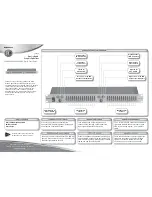
OPERATING / SERVICE MANUAL
FME 15
EQUALIZER
QUICK START
For many of you, reading an owner’s manual is about as insulting as using training wheels
on your first two-wheeler. We therefore offer the following Quick Start section which outlines
the basics of the FME 15 so briefly it counts only as familiarization material, not training.
Using the FME 15 in an insert loop of a mixer is extremely easy. Simply connect them
together using a single stereo cable (¼" TRS) between the mixer’s insert loop and the FME
15’s
PATCH I/O
jack. This jack is wired for the tip=send, ring=return convention used by
mixer manufacturers.
Anyone familiar with other graphic equalizers will find this one just as familiar. One word
of caution: the boost/cut
RANGE
switch drastically changes the impact of a given filter.
Be
careful
.
Set the
IN
and
OUT GAIN
controls to the same physical positions for unity gain through
the equalizer. That is, moving both slider handles together (keeping them aligned) always
maintains overall unity gain from input to output. Many strange gain structure conditions may
be handled with these controls. See the Operating Instructions on the back page for more
information. Most applications require only a few dB of boost or cut. Start with the
RANGE
switch in the
±6dB
position, and increase to
±12dB
only if necessary. Setting curves is as easy
as it is on all Rane graphics thanks to our unique interpolating constant-Q circuitry. For more
information on setting up your curves correctly, again, see the back page.
NEVER CONNECT ANYTHING EXCEPT AN APPROVED RANE POWER SUP-
PLY TO THE RED THING THAT LOOKS LIKE A TELEPHONE JACK ON THE
REAR OF THE FME 15.
This is an AC input and requires special attention if you do not have
an operational power supply
EXACTLY
like the one that was originally packed with your unit.
See the full explanation of the power supply requirements elsewhere in this manual.
SYSTEM CONNECTION
When first connecting the FME 15 to other components,
leave the power supply for last
. This gives you a chance to
make mistakes and correct them without damaging your
fragile speakers, ears and nerves.
INPUTS.
All three Inputs are wired in parallel and are
actively balanced (all Flex modules feature true instrumenta-
tion amplifier balanced inputs). Each works equally well.
Choose strictly from a favorite hardware point-of-view, there
will be no performance trade-offs. The wiring convention
adheres to American, British and International standards of
pin 2,
“+”
, or tip being hot; pin 3,
“–”
, or ring being return;
and pin 1, COMMON GND, or sleeve being signal ground.
Unbalanced operation involves using only pin 2, “+”, or tip as
signal; and pin 1, COMMON GND, or sleeve as ground. It is
not necessary to short any terminals or pins to any others. Due
to the true instrumentation nature of the inputs, there is no
gain reduction if pin 3, or “–”, is left open; however, if pin 3
gets shorted, it won’t hurt anything either. Use pin 1, the
shell, or the COMMON GND point on the terminal strip for
shield ground. (See Rane Note 110 for further information).
OUTPUTS.
The FME 15’s Outputs mimic the Inputs.
True balanced output interconnection only requires the use of
pin 2,
“+”
, or tip; and pin 3,
“–”
, or ring for signal transmis-
sion. It does not require pin 1, or signal ground. All the signal
exists between the two balanced leads; ground is not in-
volved. Ground is used only for
shielding. If unbalanced output is
your preference, use pin 2,
“+”
, or
tip as signal; and pin 1, COMMON
GND, or sleeve as return. Leave
pin 3, “–”, or ring open. Again,
have a look at Rane Note 110 for
more detail.
EXPANDING.
Expanding and/
or daisychaining the inputs and outputs normally uses the ¼"
jacks. Multiple parallel connectors allow using another output
to drive a second processor or amplifier without special
cabling.
PATCH I/O.
The PATCH I/O (Input/Output) jack makes
connection to mixer effects loop insert points very simple.
Just connect a shielded stereo tip-ring-sleeve (TRS) cable
between the FME 15’s PATCH I/O jack and the TRS effects
loop insert on your console. (Your mixer must use the
tip=send, ring=return effects loop wiring convention.)
SIGNAL LEVELS.
The FME 15 is designed for all line-
level signals. Signal levels from -10dBV to +4dBu or consid-
ered normal and within range (at least 16dB of headroom
exists above these levels). Do not directly connect micro-
phones into the FME 15. Use a mic preamp first.






















